Using and Caring for your Kefir
When I give people kefir granules I'm always asked how to care for them and the question takes me by surprise.
In my mind I think, "you feed them milk." But of course that doesn't really answer any of their questions.
It doesn't describe how I care for my kefir nor does it give them any idea of the amount of effort is involved ( spoiler: no effort is involved ).
To provide a better answer I'm going to describe what I do to look after my kefir.
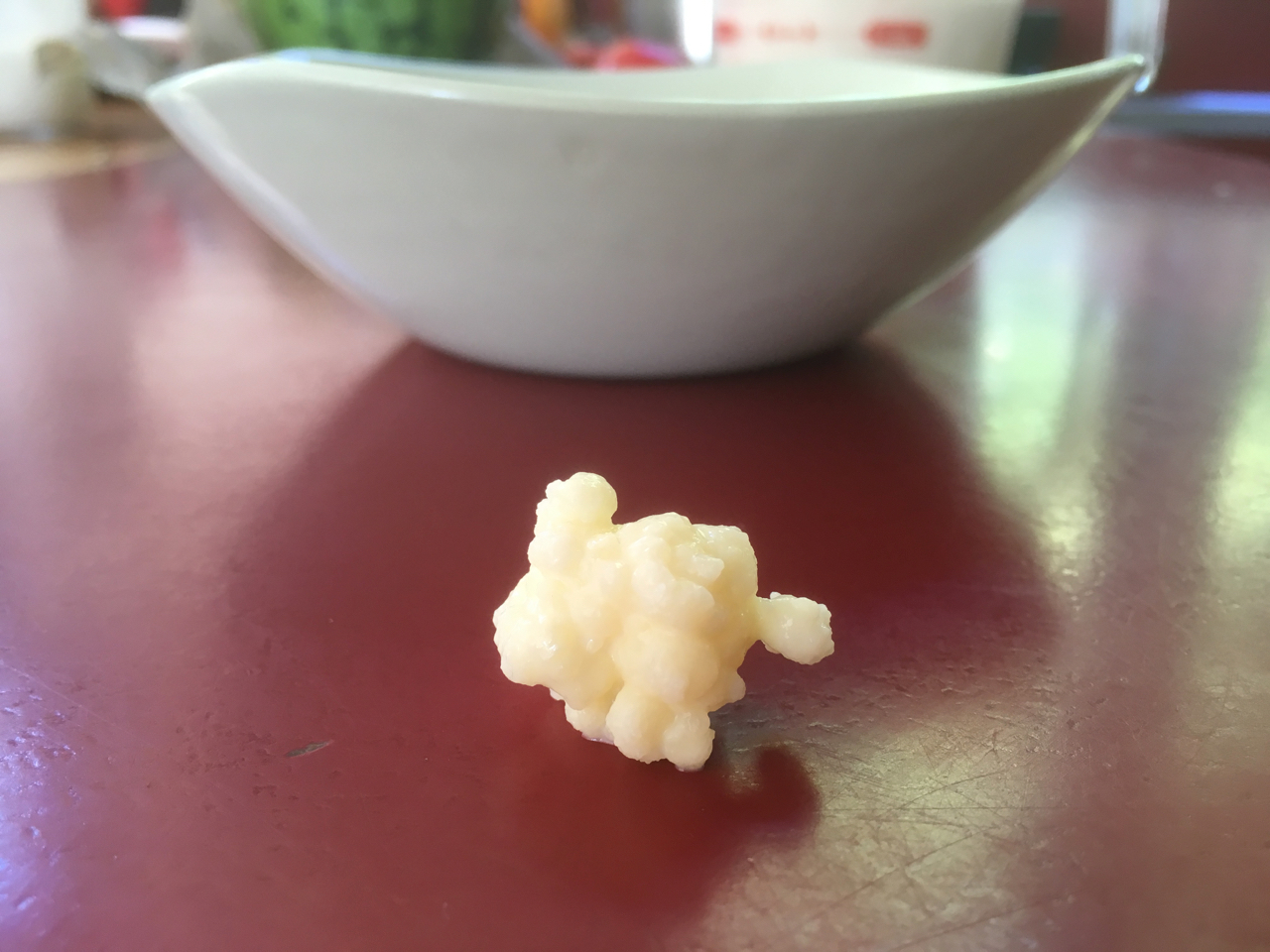
Caring for Kefir
The short story is that kefir loves milk.
When you provide your kefir with a clean environment and fresh milk it will be happy.
I use kefir to provide the cultures needed to make cheese. To do that reliably I want my kefir to be healthy and active.
The guide I use for what conditions are best for kefir is the rate it which it grows and multiplies.
My assumption is that growth occurs when the kefir is healthy and living in an environment that supports it.
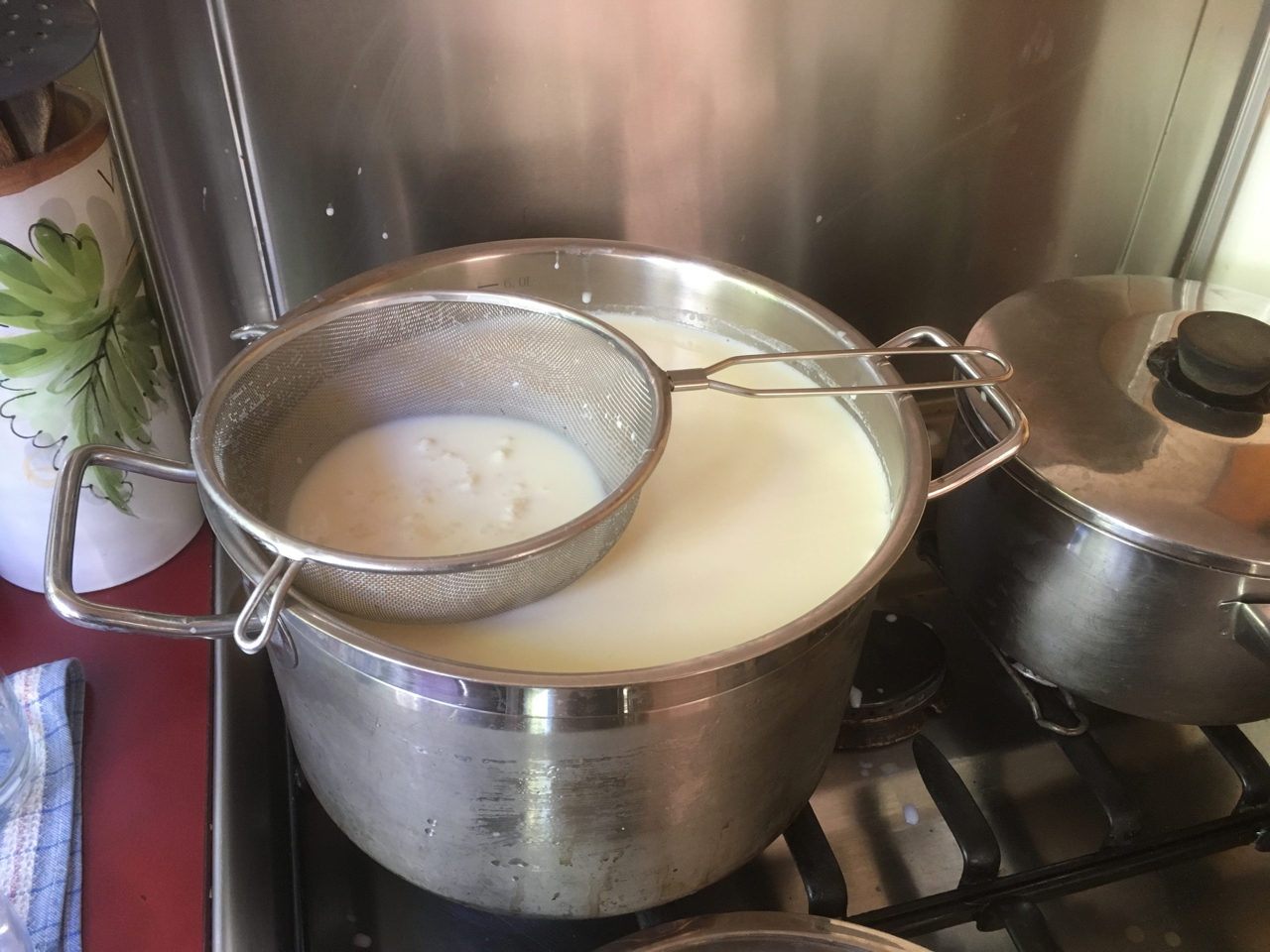
What is Kefir?
Something that I found confusing is that there are lots of things that are called kefir.
There are the kefir grains and the cultured milk that is produced by them.
The more science focused articles talk about a diverse group of yeasts and bacteria which co-exist in stable communities, and those communities are called kefir.
This goes some way to recognising that kefir is really millions of tiny pets not just a lot of cute, jelly cauliflorets dripping in milk.
You will also hear the clumps being called granules, grains, or SCOBY, which is an abbreviation of the phrase, "symbiotic community of bacteria and yeasts."
Normally I'm just as bad, but for this article I'll try to specify which form I'm talking about:
Normally I'm just as bad, but for this article I'll try to specify which form I'm talking about:
- (kefir) grains or granules are clumps bigger than a pea
- (kefir) seeds are the weeny bits that get broken off granules. (In the picture at the top of the page there is a seed protruding from the right hand side. It will probably break off as it's being handled. )
- thin kefir (pours like milk)
- thick kefir (pours like batter). It is thick and velvety, very similar to a runny yoghurt
- (kefir) curds
- (kefir) whey
- and when I say kefir without any qualifications it probably means all of the above
Housing your Kefir
If we were making cheese every day, the kefir would simply be moved from one batch of milk to the next.
However, we are in a suburban kitchen, not a dairy.
Once the kefir has done it's job we remove them from the pot and return them to storage.
In the picture below the kefir grains have been strained and placed into a bowl waiting for their home to be washed and dried.
I like to store my kefir in glass, like the old coffee jar in the picture below.
Glass jars have a lot of advantages. They are easy to clean, which is important. This jar is see-through, so I can see what is happening beneath the surface.
It has a lid which keeps out flies. It regulates the humidity so the milk doesn't evaporate easily.
Finally, it allows a reasonable surface area for the milk.
Kefir is aerobic, even though the granules are submerged they like oxygen.
The lid on this particular jar isn't airtight. If the lid did make a good seal, I would leave it loose or use a scrap of clean cloth to cover the jar.
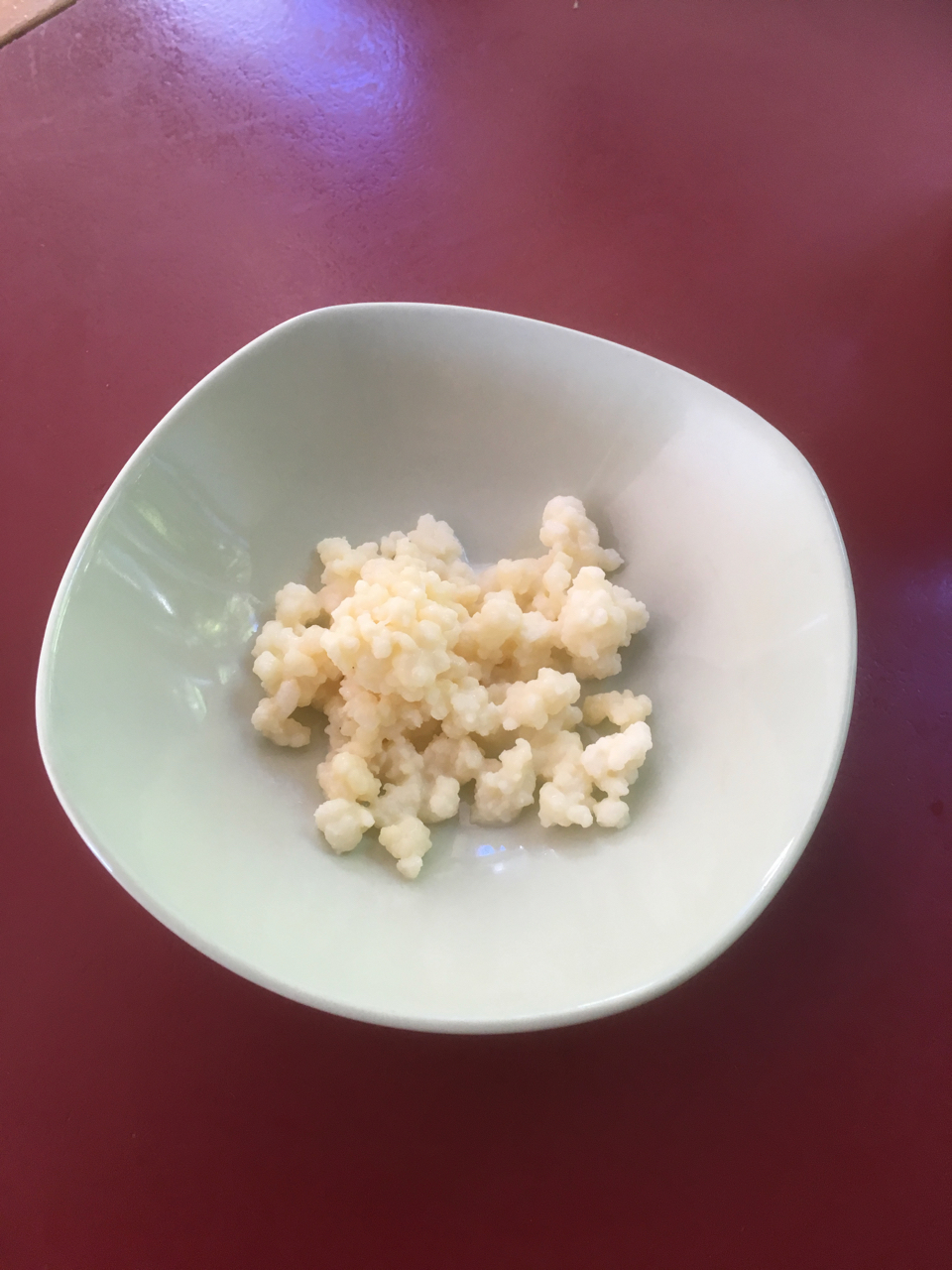
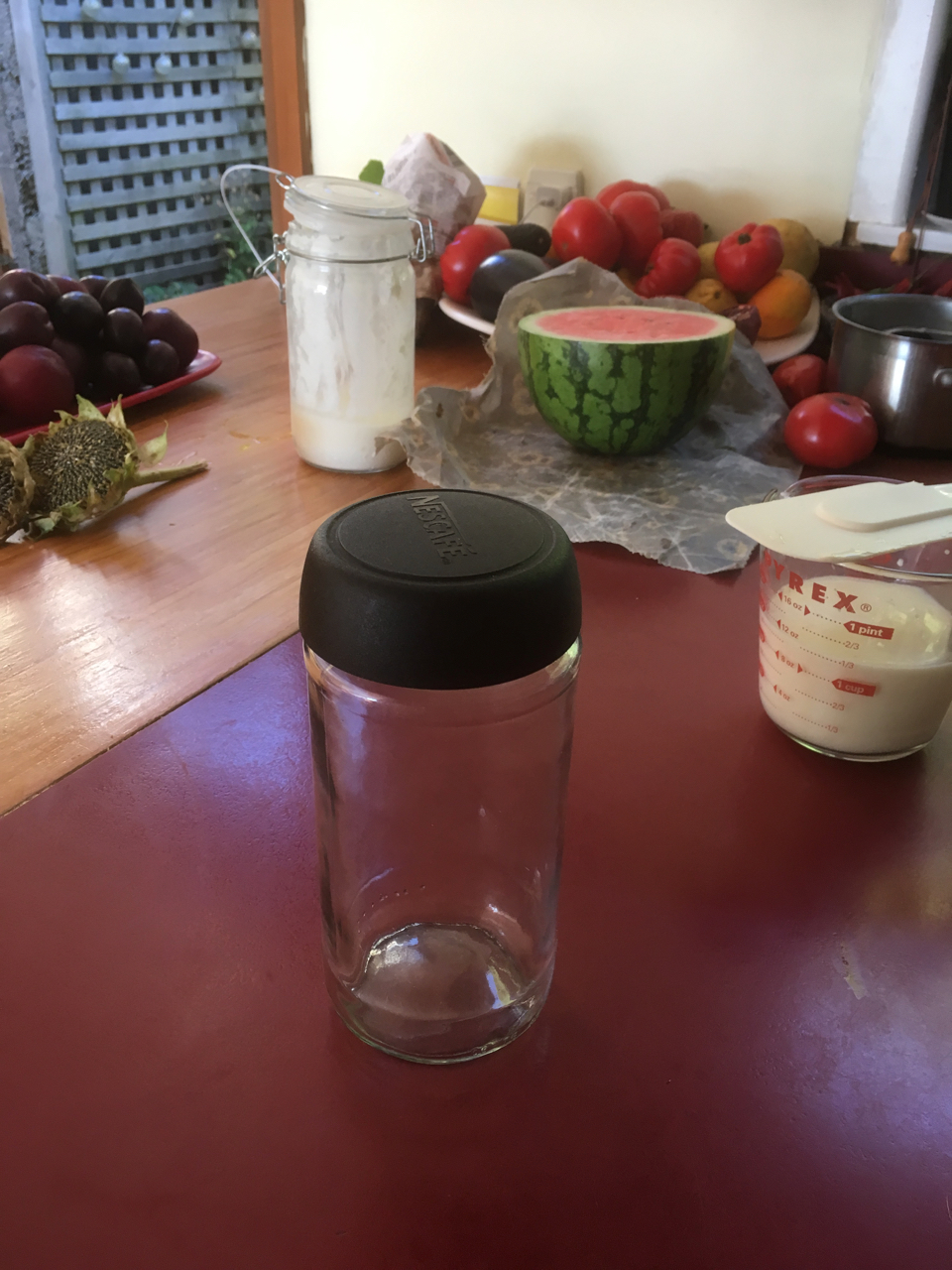
Tangent: In some of these pictures, at the left in the background you can see a jar of yoghurt. Our yoghurt cultures are all derived from kefir. We make yoghurt at least once a week and we use the same cultures. It makes delicious yoghurt.
Now I put the kefir into their jar, add fresh milk and pop the lid on.
There is a generous cup of milk covering about one third of a cup of kefir grains.
That amount of kefir grains can be used to culture a much larger volume of milk than this.
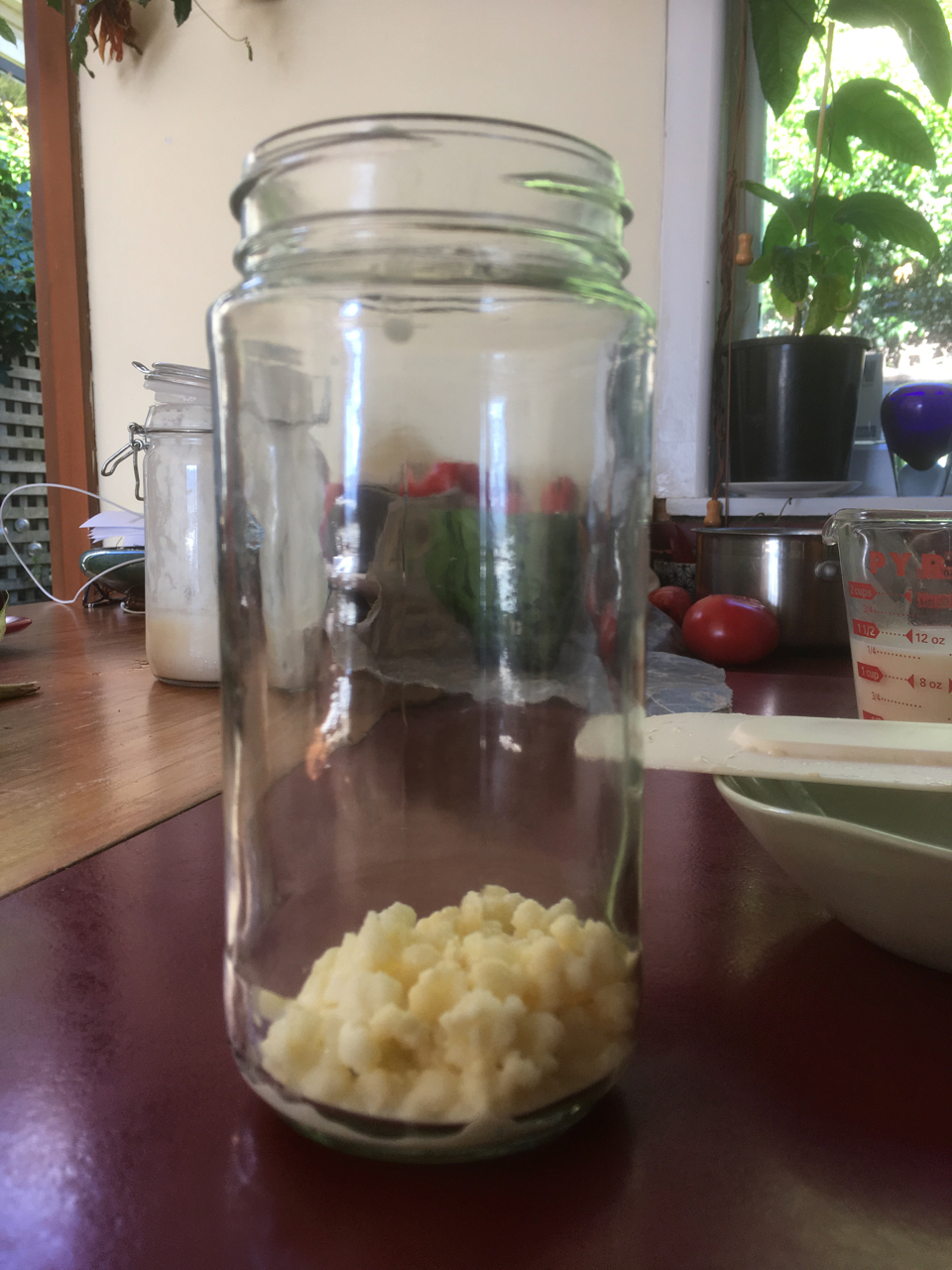
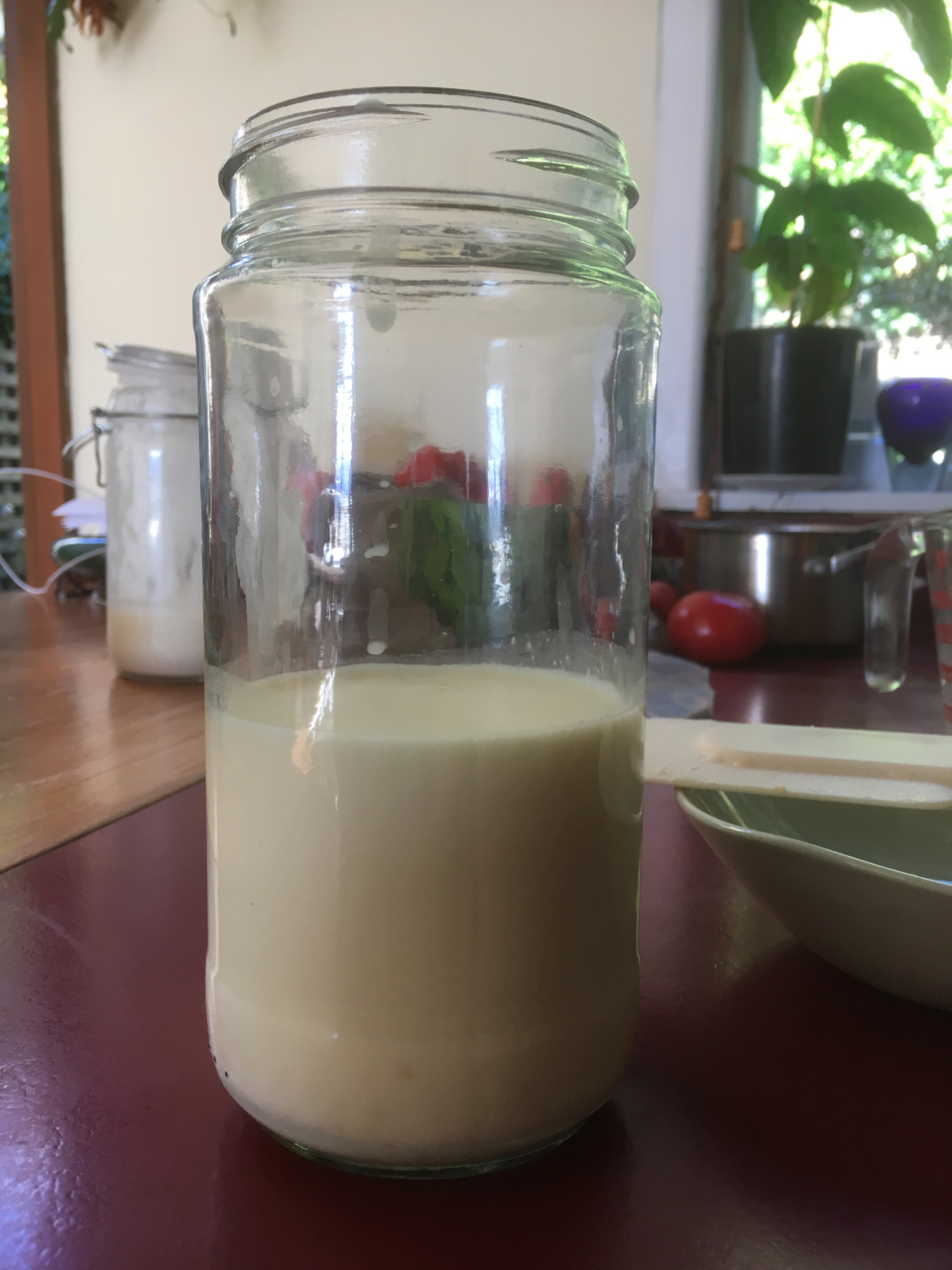

Feeding Kefir
What do you feed kefir?
Milk is the primary food source for kefir. You can use kefir as a source of culture for many different things but those things are not feeding the kefir. Many people want a non-dairy fermented drink made from coconut milk. You can use kefir grains to culture the coconut milk but you cannot leave the grains in coconut milk indefinitely. Put the grains into the coconut milk for 8-12hrs then move them back into milk. By that time plenty of culture should have transferred into the coconut milk and will continue the fermentation.
Milk is the primary food source for kefir. You can use kefir as a source of culture for many different things but those things are not feeding the kefir. Many people want a non-dairy fermented drink made from coconut milk. You can use kefir grains to culture the coconut milk but you cannot leave the grains in coconut milk indefinitely. Put the grains into the coconut milk for 8-12hrs then move them back into milk. By that time plenty of culture should have transferred into the coconut milk and will continue the fermentation.
How often should kefir be fed?
Normally I will change the milk every one or two days. I only provide a small amount of milk for the volume of kefir that I have, so frequent changes are preferable. Having said that, I've noticed that kefir grows at a faster rate when it gets fed frequently. My assumption is that fresh milk provides it with the optimal conditions for growth. What I don't know is whether that is a general benefit for the entire kefir community or whether it is encouraging the development of the gelatinous substrate that forms the granules.
Normally I will change the milk every one or two days. I only provide a small amount of milk for the volume of kefir that I have, so frequent changes are preferable. Having said that, I've noticed that kefir grows at a faster rate when it gets fed frequently. My assumption is that fresh milk provides it with the optimal conditions for growth. What I don't know is whether that is a general benefit for the entire kefir community or whether it is encouraging the development of the gelatinous substrate that forms the granules.
How long can you leave your kefir without feeding it?
Kefir is resilient and doesn't require much attention. It will not die if it doesn't have new milk everyday. It can survive for weeks in the same batch of milk. I've frequently travelled, leaving my kefir for over a fortnight without taking any extra steps for it's care. Upon my return, I strain it and feed it as normal.
Kefir is resilient and doesn't require much attention. It will not die if it doesn't have new milk everyday. It can survive for weeks in the same batch of milk. I've frequently travelled, leaving my kefir for over a fortnight without taking any extra steps for it's care. Upon my return, I strain it and feed it as normal.
Storing Kefir
Room Temperature is Best
I keep my kefir at room temperature. It usually sits on top of the fridge, sometimes it sits in the pantry. It's out of direct sunlight and through winter it's getting a little extra warmth. In our kitchen the temperature ranges from 9C overnight in winter to 22C during summer afternoons.
I keep my kefir at room temperature. It usually sits on top of the fridge, sometimes it sits in the pantry. It's out of direct sunlight and through winter it's getting a little extra warmth. In our kitchen the temperature ranges from 9C overnight in winter to 22C during summer afternoons.
Can you keep kefir in the fridge?
A fridge is not going to provide kefir with an optimal environment. Kefir can survive inside the fridge (~4C) and can be kept in the fridge for long periods of time but it prefers a warmer ambience (above 7C). Remember, the whole point of refrigeration is to restrict bacterial activity and kefir is a community of bacteria and yeasts. In general, you want your kefir to be as happy as spring lambs, not shivering through a permanent winter.
A fridge is not going to provide kefir with an optimal environment. Kefir can survive inside the fridge (~4C) and can be kept in the fridge for long periods of time but it prefers a warmer ambience (above 7C). Remember, the whole point of refrigeration is to restrict bacterial activity and kefir is a community of bacteria and yeasts. In general, you want your kefir to be as happy as spring lambs, not shivering through a permanent winter.
Extreme Storage
I've read that kefir can be frozen and thawed. Also that it can be dried and rehydrated. Wow! I know that bacteria and yeasts are extremely robust organisms. I find their ability to withstand such extreme environments impressive. I should say that I haven't tried either of those methods of storage, though I'm confident that they'd work.
I've read that kefir can be frozen and thawed. Also that it can be dried and rehydrated. Wow! I know that bacteria and yeasts are extremely robust organisms. I find their ability to withstand such extreme environments impressive. I should say that I haven't tried either of those methods of storage, though I'm confident that they'd work.
Growing Kefir
If you want to have your own kefir growing in your kitchen you'll need to find a friend or a supplier who will provide you with kefir grains.
Although it's possible to buy sachets of dried culture which is labelled as kefir you'll never generate kefir granules from these sources. These sachets contain six or more of the species that are found in kefir.
Like dried bread yeasts, kefir cultures store well as a dry product. They are easily revived and make a very nice cultured milk.
At present we don't know what conditions, nor which combination of yeasts and bacteria, are needed for kefir grains to develop.
Even when we take the kefir produced from vibrant, healthy granules and continue to replenish the milk, the kefir grains don't start growing autonomously.
If the grains are present, they grow. Otherwise, not. Read the notes on handling kefir to ensure that you aren't losing your baby kefir grains when you change their food.
Handling Kefir
Can I Touch it with my Hands?
Yes, you can touch kefir granules with your hands. It won't hurt you and it won't hurt them. Kefir granules are robust little things that can withstand careless handling. I've dropped them in the dirt, tossed them down the sink, left them in the cheese, left them out of their milk for the weekend, you get the picture. All you need to do is tell your kefir that you're sorry as you pop them back into their milky home.
Yes, you can touch kefir granules with your hands. It won't hurt you and it won't hurt them. Kefir granules are robust little things that can withstand careless handling. I've dropped them in the dirt, tossed them down the sink, left them in the cheese, left them out of their milk for the weekend, you get the picture. All you need to do is tell your kefir that you're sorry as you pop them back into their milky home.
Straining or Sieving Kefir
Using a fine metal sieve to strain your kefir will ensure that you don't lose all your kefir seeds.
my kefir gets handled when I toss it into a sieve to strain the kefir. I'll use my fingers or a spatula to stir the granules, or toss the whole mass gently until the kefir has poured through leaving the granules in the sieve. Even when you do this very gently, the little seeds will break off the larger granules. For a long time I used a spaghetti colander to strain my kefir because the large slats allowed the kefir to pass through very quickly. There was no waiting but there where no seeds left behind either. The seeds can be tiny, less than a millimetre across. At that size they slipped through the slats in the colander and they'd be eaten without anyone noticing. After I started using a sieve, I noticed my kefir population exploding. The tiny seeds grow quite quickly and, like kittens, as they bulk up you'll find yourself asking friends and neighbours if they want to take some off your hands
Using a fine metal sieve to strain your kefir will ensure that you don't lose all your kefir seeds.
my kefir gets handled when I toss it into a sieve to strain the kefir. I'll use my fingers or a spatula to stir the granules, or toss the whole mass gently until the kefir has poured through leaving the granules in the sieve. Even when you do this very gently, the little seeds will break off the larger granules. For a long time I used a spaghetti colander to strain my kefir because the large slats allowed the kefir to pass through very quickly. There was no waiting but there where no seeds left behind either. The seeds can be tiny, less than a millimetre across. At that size they slipped through the slats in the colander and they'd be eaten without anyone noticing. After I started using a sieve, I noticed my kefir population exploding. The tiny seeds grow quite quickly and, like kittens, as they bulk up you'll find yourself asking friends and neighbours if they want to take some off your hands
Can I Press them Flat?
No!
They don't like to be squashed flat.
They don't like to be squeezed until they pop.
They don't like to be boiled.
They don't like to be disinfected.
No!
They don't like to be squashed flat.
They don't like to be squeezed until they pop.
They don't like to be boiled.
They don't like to be disinfected.
Cleaning Kefir
If you feed your kefir regularly you'll never need to clean it. If you are moving your kefir from one medium to another, such as milk to coconut milk, milk to fruit juice, or back the other way, you'll probably want to rinse the granules in cold water on their way from one medium to the other.
If you've used your kefir to culture a fruit or berry juice, your granules will be almost the same colour as the juice. Your kefir is perfectly healthy, even though it is now one of the shades of the sunset. When you put your kefir back into milk they are very easy to spot! You can't wash the colour out, it will fade with time.
In kefir-land, clean does not mean sterile. Clean kefir means rinsed under a tap or in a glass of milk and a gentle pat to remove excess liquid. Clean utensils means no left-over bits stuck to surfaces, no oily surfaces, no sticky goop, no dust nor lint. To clean your utensils, wash them in warm water with a little soap, rinse and dry them.
If you have dropped your kefir on the floor, or tossed it down the sink and recovered it from the u-pipe, etc, then your family and your friends will appreciate it if you give your kefir a rinse in cold water or milk before you pop it back into it's milky home.
If you feed your kefir regularly you'll never need to clean it. If you are moving your kefir from one medium to another, such as milk to coconut milk, milk to fruit juice, or back the other way, you'll probably want to rinse the granules in cold water on their way from one medium to the other.
If you've used your kefir to culture a fruit or berry juice, your granules will be almost the same colour as the juice. Your kefir is perfectly healthy, even though it is now one of the shades of the sunset. When you put your kefir back into milk they are very easy to spot! You can't wash the colour out, it will fade with time.
In kefir-land, clean does not mean sterile. Clean kefir means rinsed under a tap or in a glass of milk and a gentle pat to remove excess liquid. Clean utensils means no left-over bits stuck to surfaces, no oily surfaces, no sticky goop, no dust nor lint. To clean your utensils, wash them in warm water with a little soap, rinse and dry them.
If you have dropped your kefir on the floor, or tossed it down the sink and recovered it from the u-pipe, etc, then your family and your friends will appreciate it if you give your kefir a rinse in cold water or milk before you pop it back into it's milky home.
- Don't Sterilise. Don't Anti-bac
- Your very cute, jelly cauliflorets will die if they are sterilised.
- Don't use sterilising cleaning fluids, antiseptics or anti-bacterial cleaners on surfaces or utensils that you will bring into contact with your kefir.
- Don't put any of those things into your kefir.
- Don't put your kefir into any of those liquids.
Healthy Kefir
The pictures of kefir on this page show you how kefir granules look when they are healthy.
Kefir granules are soft and gelatinous. They are firm, not sloppy.
You can see that they support themselves easily, they don't sag.
Kefir has a slighty viscous coating which is a little bit slippery but not stringy or ropy.
There are clumpy types of kefir that look a bit like jelly cauliflorets and there are flat types that spread like doilies.
The granules in these pictures are clumpy, cauli-jellies.
How Hungry is my Kefir?
Normal Hungry
When kefir has been left for a day or two without changing the milk you'll see some changes. The most obvious change is that the milk forms into curd. Kefir produces acids as a by-product of their activity. The acidification assists in the preservation of the milk and is a part of the reason that kefir is considered beneficial. When acid levels in milk rise modifications of the proteins occur resulting in very delicate, translucent white curds with a tart flavour. This is clabber. At this stage, if you sieve the granules away you'll have a thin kefir.
When kefir has been left for a day or two without changing the milk you'll see some changes. The most obvious change is that the milk forms into curd. Kefir produces acids as a by-product of their activity. The acidification assists in the preservation of the milk and is a part of the reason that kefir is considered beneficial. When acid levels in milk rise modifications of the proteins occur resulting in very delicate, translucent white curds with a tart flavour. This is clabber. At this stage, if you sieve the granules away you'll have a thin kefir.
Extra Hungry
When acid levels increase further the curd splits, resulting in clear whey and firm, white curds. At a glance, you'll see more curds than whey. The whey will be slightly tart. The curds are whey can be stirred together to create a thick kefir. You can store this in the fridge for a week or longer. It will thicken up and become more acidic over time. It retains a lot of protein (whey proteins) and is bacterially active. If you have a taste for tart food, it is a nutritious drink full of probiotic cultures.
When acid levels increase further the curd splits, resulting in clear whey and firm, white curds. At a glance, you'll see more curds than whey. The whey will be slightly tart. The curds are whey can be stirred together to create a thick kefir. You can store this in the fridge for a week or longer. It will thicken up and become more acidic over time. It retains a lot of protein (whey proteins) and is bacterially active. If you have a taste for tart food, it is a nutritious drink full of probiotic cultures.
Missed-a-meal Hungry
When acid levels continue to increase the curds solidify, resulting in clear whey and solid, white curds. At a glance you'll see more whey than curds and the kefir may be bubbling. The whey will be sour. The curds can be used like cottage cheese. The granules will separate easily from the curds.
When acid levels continue to increase the curds solidify, resulting in clear whey and solid, white curds. At a glance you'll see more whey than curds and the kefir may be bubbling. The whey will be sour. The curds can be used like cottage cheese. The granules will separate easily from the curds.
Eat-a-Horse Hungry
There is white mould on the surface. A furry, white, surface mould is Penicillin candidum. A winkly, white, surface mould is Geotrichum candidum. Both of these surface moulds are naturally present in kefir. They give many of the most delicious, soft, white cheeses their character. The kefir may be bubbling. The curds will have a sharp tang. Lightly salt the curds and use them as an alternative to fetta in baking. The curds and whey are probably not appetising, the whey will be very acidic now, like vinegar. The curds will be softening as the acids break down the proteins. The granules separate easily from the curds and appear clean.
There is white mould on the surface. A furry, white, surface mould is Penicillin candidum. A winkly, white, surface mould is Geotrichum candidum. Both of these surface moulds are naturally present in kefir. They give many of the most delicious, soft, white cheeses their character. The kefir may be bubbling. The curds will have a sharp tang. Lightly salt the curds and use them as an alternative to fetta in baking. The curds and whey are probably not appetising, the whey will be very acidic now, like vinegar. The curds will be softening as the acids break down the proteins. The granules separate easily from the curds and appear clean.
I'm not Hungry - I'm Starving!
There is a heavy, white mould on the surface. The granules will have separated from the curds. They may appear smaller or shrunken. They have become slack and droopy. Their coating will be very slimy and it will stretch without breaking.
Feed your Kefir! Change the milk regularly while your kefir regain their strength. Kefir normally has a little bit of sparkle on the tongue but you'll notice that there is a lot more bubble while your kefir recovers.
There is a heavy, white mould on the surface. The granules will have separated from the curds. They may appear smaller or shrunken. They have become slack and droopy. Their coating will be very slimy and it will stretch without breaking.
Feed your Kefir! Change the milk regularly while your kefir regain their strength. Kefir normally has a little bit of sparkle on the tongue but you'll notice that there is a lot more bubble while your kefir recovers.
Sick Kefir
Health problems are uncommon but they can occur. What are the signs to look for?
If it's any Colour but White
The surface cultures found in kefir are white. Any other colour is the flag of an invader. Bacteria and yeasts are everywhere and they find their way into your kefir every minute of the day. That's normal. A healthy kefir will overwhelm the new arrivals as soon as they arrive. This is taking place at a microbial level and you'll never see any sign of it. It's the normal state of affairs. If another species has arrived and survived for long enough to be visible to the human eye it is a signal that your kefir needs fresh milk.
The surface cultures found in kefir are white. Any other colour is the flag of an invader. Bacteria and yeasts are everywhere and they find their way into your kefir every minute of the day. That's normal. A healthy kefir will overwhelm the new arrivals as soon as they arrive. This is taking place at a microbial level and you'll never see any sign of it. It's the normal state of affairs. If another species has arrived and survived for long enough to be visible to the human eye it is a signal that your kefir needs fresh milk.
If it Smells Bad it is Bad
Healthy kefir smells sour. Sour smells can cover quite a range, from lemon to vinegar. Sour is good. Sour is healthy. Any other smells mean that there is an invasive species that is active. Try to feed your kefir back to health.
Healthy kefir smells sour. Sour smells can cover quite a range, from lemon to vinegar. Sour is good. Sour is healthy. Any other smells mean that there is an invasive species that is active. Try to feed your kefir back to health.
Are the Grains Limp or Soft?
Healthy kefir is firm. Look at the granule pictured at the top of the page. It is supporting itself. If your kefir grains aren't vigourous you should feed them more often.
Healthy kefir is firm. Look at the granule pictured at the top of the page. It is supporting itself. If your kefir grains aren't vigourous you should feed them more often.
Feed Your Kefir Back to Health
Recover your grains by straining them off the curds and whey and washing them with water or milk. Place them into a clean jar and cover them with milk. Replace the milk daily until your kefir recover their vibrant, good health.
Recover your grains by straining them off the curds and whey and washing them with water or milk. Place them into a clean jar and cover them with milk. Replace the milk daily until your kefir recover their vibrant, good health.
Making Changes to Support Good Health
If your kefir has become unwell, you need to make some changes to the way you care for your kitchen pets. The best way to care for kefir is to provide a clean environment and ensure it is fed regularly.
If your kefir has become unwell, you need to make some changes to the way you care for your kitchen pets. The best way to care for kefir is to provide a clean environment and ensure it is fed regularly.
- If you haven't been feeding your kefir, it's time to feed it more often.
- If you had been storing your kefir in the fridge, it's time to store them at room temperature.
- If you had been storing your kefir in direct sunlight, it's time to store them in a shady spot.
- If you had been storing your kefir in the same jar without washing it for months on end, it's time to use a clean jar.
Enjoying your Kefir
Use your kefir to make lots of delicious things
- drink the thin kefir as a nutritious probiotic
- add salt to make a thirst quenching lassi
- blend with ripe fruits to make delicious sweet lassi
- Allow to thicken until it has a velvety texture.
- Use thickened kefir with your fruit and cereal at breakfast.
- Use thickened kefir as a substitute for yoghurt in curry sauces and casseroles. It doesn't split.
- Use kefir as a culture to make yoghurt.
- Use kefir as a culture to make cheese.
In Summary
Kefir are easy to care for, feed them fresh milk regularly, keep them in a clean environment at room temperature, covered but with plenty of air. They are very useful in the kitchen and you can use their cultures in all sorts of ways.
If you have any other questions send an email to kefir@notyourhomework.net.
Malcolm